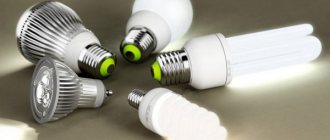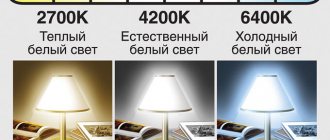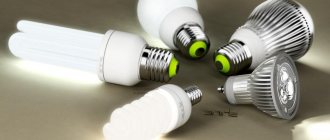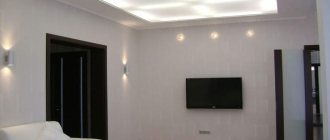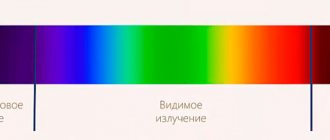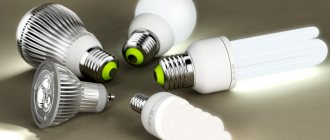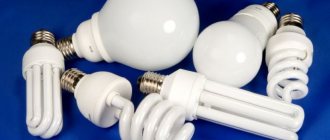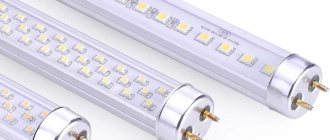All over the world there is a clear trend towards the transition to energy-saving lighting sources. The most economical ones today are fluorescent and LED lamps. Let's make a comparison and determine which light sources are better - LED or energy-saving?
There are also metal halide light sources, which have a luminous efficiency at the level of LEDs, but the high price of ballasts precludes their widespread use. Their destiny is lighting sources with a luminous flux of tens of thousands of lumens.
To understand which light bulbs are better, LED or energy-saving, let’s look at their key features.
Design Features
Despite their external similarity, LED and energy-saving lamps have significant structural differences. What is the difference between LED lamps and energy-saving lamps?
First of all, the difference is in the principle of obtaining light flux.
LEDs use LEDs of an open design or placed in a plastic flask as a light emitter. The energy saving device has a glass tube filled with a special gas and coated on the inside with a phosphor.
Accordingly, LEDs are much more resistant to mechanical stress.
To ignite a fluorescent lamp on a spiral, it is necessary to apply a short-term high-voltage discharge, and at low voltage in the network they may not light up.
Mercury is used in the manufacture of fluorescent lamps. Such products require special disposal methods. In Europe, there is an administrative penalty for throwing energy-saving lamps into the trash bin.
Bottom line: LED lamps are better in terms of design features
Price range
The cost of high-quality LED or fluorescent lamps is approximately the same - from 200 rubles for one product. It all depends on the price-quality ratio given by the manufacturer. It is better to buy products from world brands - OSRAM, Phillips, Era, Cosmos. They produce high-quality, reliable and proven products.
Important! There are currently a large number of counterfeit Chinese LED lamps being sold. It is not recommended to buy them - they will quickly break and will not perform their functions fully.
Comparison by light output efficiency
Click to enlarge
If we compare the ratio of energy consumption and luminous flux, LEDs have a better ratio. Thus, an energy-saving device with a power of 13W gives a luminous flux of about 700 lumens, the power of LEDs with the same luminous flux is 7-9W.
It should be taken into account that over time, the luminous flux of all gas-discharge light sources decreases. The answer to the question of which lamps are more economical, LED or energy-saving, is obvious.
The savings of LED lamps compared to energy-saving lamps, even without taking into account the service life, are at least twofold.
Efficiency
The efficiency of the light bulb is also indicated by the ratio of the luminous flux to the operating power of the lighting element. This value isolates a certain set of indicators and is called efficiency (efficiency factor) or “luminous efficiency”. Measured in lm/W. The higher the indicator, the more economical the lamp operates.
For an incandescent lamp this value is very low - less than 10 lm/W, therefore, it has a very low luminous efficiency. This is its most significant drawback. For comparison: the average efficiency of an ice lamp is 90%; for most energy-saving ones it is below 90%.
To make it easier to make a choice, it is worth considering how else these types of lamps differ.
Let's compare service life
According to the passport data, the service life of an energy-saving lamp is 15,000-20,000 hours, and that of an LED lamp is 35,000 hours. As practice shows, the real indicators of “energy saving” companies are much worse.
When calculating the lifetime of a gas-discharge lamp, the manufacturer takes ideal conditions: the number of on/off switches during the day is no more than five, the absence of temperature and voltage changes.
In an average apartment, even if the light bulb is not located in a public place, such as a toilet or bathroom, its lifespan rarely exceeds 5000-6000 hours. And if you consider that in a couple of years the luminous flux will decrease by 30% and even less.
High-quality LEDs, providing stable voltage and current, last much longer.
How is the service life of a product determined?
For any industrial product, a load test is carried out. For shoes, for example, a robotic leg takes one hundred thousand steps, after which wear is assessed, similarly, any device with mechanical loads is examined.
For LEDs, they organize a multi-month marathon with continuous switching on/off and supplying increased current. Based on the results of such tests, the predicted service life of the LED can reach one hundred thousand hours.
Aging factor
Any gas-discharge lamp, including a fluorescent lamp, decreases in brightness during operation. This is caused by the evaporation of tungsten from the spirals and the burnout of the phosphor covering the inside of the glass bulb.
Bottom line: In terms of service life, LED lights are better.
Effect on the human body
Fluorescent tubes contain mercury vapor, which, when sealed, escapes into the air, which is dangerous to human health. The operation, storage and disposal of such devices require special attention, because negligence leads to the release of mercury compounds into the human environment, soil, and water. Massive violation of the rules for the disposal of mercury elements creates a threat of large-scale environmental pollution.
Luminescent sources work by converting ultraviolet radiation into visible light with a phosphor. The fluorescent coating and glass transmit a portion of ultraviolet radiation to the outside, and burnout of the phosphor leads to an increase in the flux of UV radiation, which has a harmful effect on the skin. A person does not see or feel UV radiation, and therefore does not suspect the cause of the disease.
LED production technology eliminates the emission of ultraviolet spectrum by LED lamps during operation. Infrared radiation is present, but does not exceed 15%, which is safe for humans. The absence of harmful compounds in LED elements confirms the environmental friendliness of the devices.
With prolonged use of fluorescent lamps, the fluorescent coating fades, the intensity of ultraviolet radiation increases, which negatively affects health.
Is it possible to control the brightness (dimming)
Dimming – controlling the brightness of a light source. LEDs allow you to change the brightness over a wide range. It is impossible to reduce the brightness of a gas-discharge lamp by reducing the voltage.
For these purposes, quite expensive high-frequency electronic ballasts are used. Changes in brightness are achieved by passing pulses with a frequency of about 50 kHz. With this mode of operation, the life of the device is significantly reduced.
Colorful temperature
According to these indicators, energy-saving and LED lamps are twins. Both have gradations of warm white, neutral white, cool white light.
Color rendering index
And again LEDs are better. An ordinary fluorescent lamp has a smaller emission spectrum than an LED. Only energy-saving lamps with a three-component phosphor, like LEDs, have an index of 80-90; in other models, the color rendering index is 60-80.
Bottom line: LED lights can freely adjust their brightness. Energy saving lamps - no. LED bulbs have the advantage.
terms of Use
Operating conditions for LED lamps:
- do not use in closed luminaires to avoid overheating;
- installation and dismantling is carried out only with the power supply turned off;
- The lamps should be wiped with a dry soft cloth; aggressive detergents should not be used for cleaning;
- if the light bulb is brought from the cold, you need to keep it at room temperature for 30 minutes and then turn it on;
- The mains voltage should not be higher than 250 V.
Rules for operating energy-saving fluorescent lamps:
- do not turn the lamp on and off frequently;
- It is undesirable to use during voltage surges;
- Do not break the flask, as it contains mercury vapor inside;
- You can touch the lamps with gloves or with a rag - grease marks can cause the bulb to explode;
- It is better to install in open lamps;
- The lamp can only be replaced when the electrical power is turned off;
- Disposal is carried out only at specialized collection points.
If all operating rules are followed, the device will last a long time and will perform its functions fully.
Comparison of resistance to adverse factors
When used in rooms with high humidity or dust, the service life of energy-saving paws is significantly reduced. What is the difference between LED lamps and energy-saving ones?
LEDs are practically not afraid of contamination and mechanical cleaning of the surface. At the same time, the bulb of a gas-discharge lamp categorically does not accept touching. When installing a new energy-saving device, it is recommended to screw it into the cartridge without touching the glass bulb.
True, there is one interesting phenomenon: at very low temperatures, incandescent lamps show incomparably better results. I recommend checking out the experiment:
Appearance: base type
The perception of interior design largely depends on the quality of lighting in the room. A correctly selected lighting option will highlight the advantages of the interior and hide the shortcomings. An important aspect, without which it will not be possible to implement such a design move, is the choice of a suitable shape and pleasant appearance of lamps for modern lighting fixtures.
Having decided on the type of light bulb, a person pays attention to the type of base. They are:
- Standard or screw. The most common in everyday life are E14 (minion) and E27. The number indicates the diameter of the base. There are no installation features provided. Light bulbs with sockets of type E40, E27 or E14 are allowed to be mounted in standard incandescent lamp sockets. The E27 base has a thread of 27 millimeters, and the E14 has a reduced thread of 14 millimeters.
- Pin. In everyday life they are not used as often as screw ones. Pin contacts are more often used in luminaires of modern lighting options. The marking of the cartridge is very important.
The number that follows the letter marking of this type of base is the distance between the pins, indicated in millimeters (GU4 or GU5.3, etc.).
After selecting the base, the type and size of the lighting electrical elements is selected. LED and halogen lamps have a more original shape (candle, ball) and beautiful design. Luminescent ones can only have the shape of a spiral or tube.
Final table comparing LED and energy-saving lamps
| Criterion | LEDs | Fluorescent light source |
| Design reliability | + | — |
| Light output efficiency | + | — |
| Brightness control | + | — |
| Pollution resistance | + | — |
| Economical | + | — |
| Price | — | + |
As we can see, the only criterion by which energy-saving light sources are better is low base cost. But it should be taken into account that energy costs during operation will significantly exceed the difference in cost. So, despite the cost, LED lamps are better than energy-saving ones.
Please rate the article. We tried our best:)
Did you like the article? Tell us about her! You will help us a lot :)
The most popular manufacturers
To purchase a reliable lamp, you should consider products only from popular brands that have earned the trust of consumers. Now on the market you can find many offers from Chinese manufacturers offering tempting prices. But such products are rarely reliable and often burn out.
LED lamp manufacturers
Experts advise giving preference to the following brands:
- Philips.
- Osram.
- ASD.
- Jazzway.
- Gauss.
- Camelion.
- Feron.
They have proven themselves to be the best in the market of LED lamps, as well as various household appliances. The highest ratings are from Osram and Philips.
